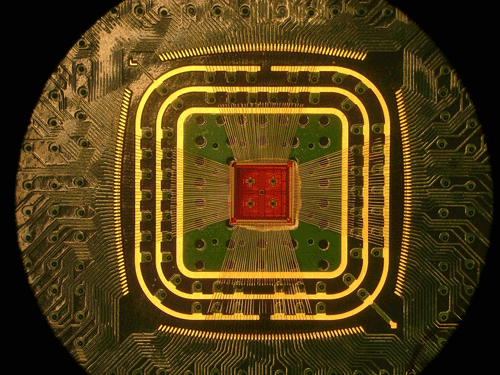Penn works with Columbia engineers to increase speed of single-molecule measurements
Media Contact:Evan Lerner | elerner@upenn.edu | 215-573-6604
PHILADELPHIA — As nanotechnology becomes ever more ubiquitous, researchers are using it to make medical diagnostics smaller, faster and cheaper in order to better diagnose diseases, learn more about inherited traits and more. But as sensors get smaller, measuring them becomes more difficult; there is always a tradeoff between how long any measurement takes to make and how precise it is. And when a signal is very weak, the tradeoff is especially big.
Marija Drndic’, an associate professor in the Department of Physics and Astronomy in the University of Pennsylvania School of Arts and Sciences, worked with a team of researchers at Columbia University’s engineering school, led by Ken Shepard, to figure out a way to measure using nanopores, tiny holes in a thin membrane that can detect single biological molecules such as DNA and proteins, with less error than can be achieved with commercial instruments.

Photograph of the amplifier chip, attached to a circuit board with thin gold wirebonds. (Credit: Columbia Engineering)
Their research was published in the journal Nature Methods.
Scientists are interested in nanopores because they may lead to extremely low-cost and fast DNA sequencing. But the signals from nanopores are very weak, so it is critically important to measure as cleanly as possible. In their study, the researchers miniaturized the measurement by designing a custom-integrated circuit using commercial semiconductor technology, building the nanopore measurement around the new amplifier chip.
“While most groups are trying to slow down DNA, our approach is to build faster electronics,” Drndić said. “We combined the most sensitive electronics with the most sensitive solid-state nanopores.”
“We put a tiny amplifier chip directly into the liquid chamber next to the nanopore, and the signals are so clean that we can see single molecules passing through the pore in only one microsecond,” said Jacob Rosenstein, a Ph.D. candidate in electrical engineering at Columbia and lead author of the paper. “Previously, scientists could only see molecules that stay in the pore for more than 10 microseconds.”
Many single-molecule measurements are currently made using optical techniques, which use fluorescent molecules that emit photons at a particular wavelength. But, while fluorescence is very powerful, its major limitation is that each molecule usually produces only a few thousand photons per second.
“This means you can’t see anything that happens faster than a few milliseconds, because any image you could take would be too dim,” Columbia Engineering’s Shepard said. “On the other hand, if you can use techniques that measure electrons or ions, you can get billions of signals per second. The problem is that for electronic measurements there is no equivalent to a fluorescent wavelength filter, so, even though the signal comes through, it is often buried in background noise.”
Shepard’s group has been interested in single-molecule measurements for several years looking at a variety of novel transduction platforms. They began working with nanopore sensors after Drndic gave a seminar at Columbia Engineering in 2009.
“We saw that nearly everybody else measures nanopores using classical electrophysiology amplifiers, which are mostly optimized for slower measurements,” Shepard said. “So we designed our own integrated circuit instead.”
Rosenstein designed the new electronics and did much of the lab work. Drndić’s group fabricated the nanopores that the team then measured in their new system.
“It’s very exciting to be able to make purely electronic measurements of single molecules,” Rosenstein said. “The setup for nanopore measurements is very simple and portable. It doesn't require a complicated microscope or high-powered instruments; it just requires attention to detail. You can easily imagine nanopore technology having a major impact on DNA sequencing and other medical applications within the next few years.”
This research was funded by the National Institutes of Health, the Semiconductor Research Corporation and the Office of Naval Research.
Advertisement
Learn more about University of Pennsylvania





